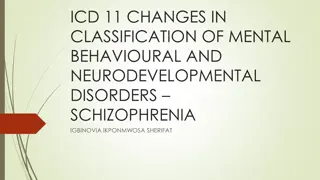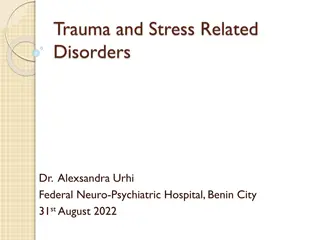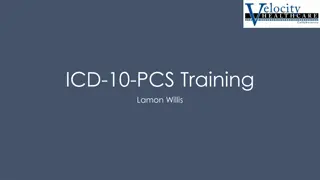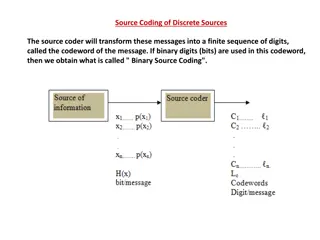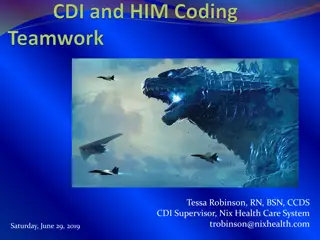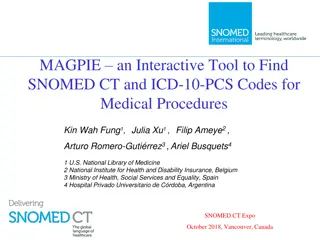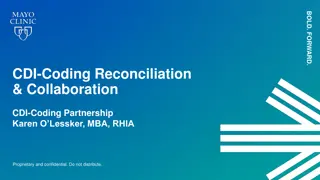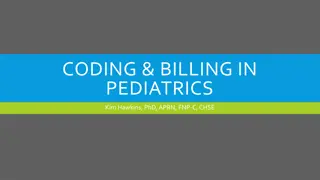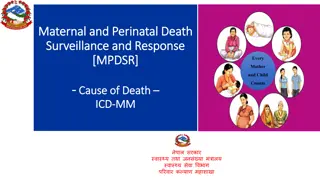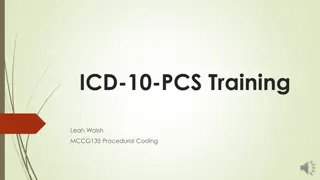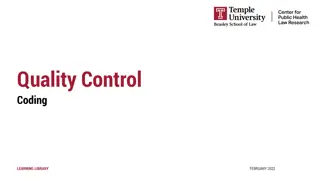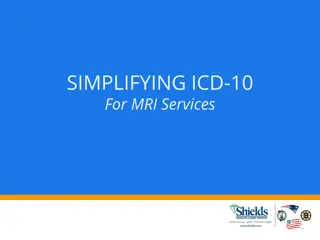Understanding ICD-11 and Morbidity Coding Principles
ICD-11 is a classification system that groups entities based on statistical relevance and specificity of codes. Entities without specific codes are assigned to residual codes (Y for specified, Z for unspecified) based on hierarchy. Examples illustrate the differentiation between specified and unspecified disease codes. Morbidity coding principles emphasize clear reporting of main and other diagnoses, avoiding abbreviations, and detailing treatment procedures for quality diagnoses. Improvement feedback highlights the need to avoid generic terms in diagnosis records.
Download Presentation

Please find below an Image/Link to download the presentation.
The content on the website is provided AS IS for your information and personal use only. It may not be sold, licensed, or shared on other websites without obtaining consent from the author. Download presentation by click this link. If you encounter any issues during the download, it is possible that the publisher has removed the file from their server.
E N D
Presentation Transcript
Coding other specified & unspecified (e.g. residuals)
Classifications A classification contains groupings of similar entities ICD-11 is a classification Some of these entities will have a specific/individual code High frequency disease, statistical relevance, morbidity and mortality needs Other entities will NOT have a specific/individual code Rare disease, low statistical relevance, poor specificity
Groupings All groupings have a hierarchy For example: Anatomy Disease type Severity The hierarchy determines what is an other specified or unspecified entity for a particular grouping
Other specified & Unspecified Entities without a specific/individual code are assigned to one of the residual codes of the grouping based on the hierarchy Other specified (Y) Unspecified (Z) If the entity contains hierarchical detail that is not included in the codable entities assign the Other specified residual code If the entity does NOT contains hierarchical detail assign the Unspecified residual code
Examples from ICD-11 Other specified DA2Y Other specified diseases of oesophagus
Examples from ICD-11- Unspecified DA2Z Diseases of oesophagus, unspecified
Principles of Morbidity coding
Basics Good quality diagnoses Clearly reported Main diagnosis Other diagnoses Avoid abbreviations Clearly formulated treatment procedures Side treatments maybe for the other diagnoses (e.g. medication)
Feedback from the analysis of diagnosis data in TMS Over 10.000 dx terms refer to Other Diagnosis term is too generic: e.g. ophthalmology, vision problem, Urology, PATIENT ADMITTED UNDER CHRONIC DISEASES etc. Diagnosis term is confounding multiple diagnosis: e.g. TDM WITH CKD WITH UREMIC ENCEPHALOPATHY WITH SEPSIS Diagnosis term refers to medical procedures: e.g. plan for lap cholecystectomy, SURGERY, URETEROSCOPY Diagnosis term use medical jargon: e.g. PHACO PCIOL PLUS SOR; PCI TO LAD AND RCA Diagnosis term is not referring to diagnosis: e.g. PATIENT ADMISSION, Without Exploration, SAFE CONFINEMENT, PRIVATE WARD, POSITIVE, PATIENT ADDMISION, Sheet Attached Diagnosis term has spelling mistakes: e.g. unstable ungina, URETRIC CALCULAS, URETRIC CALCULIS
Challenges from a clinical coders perspective Clinical case description is not diagnosis If it s not written well, it can t be coded well Clinical statement Unable to void, for IDC insertion Low HB for transfusion Diagnostic statement Urinary retention Acute or chronic blood loss anaemia, iron deficiency anaemia Dehydration Urine output , will bolus with IV fluids LUL infiltrate/consolidation, IV antibiotics LUL pneumonia
Main condition and Other conditions Main condition (principal diagnosis) Answers the question: Why is the patient here today? Is the diagnosis, condition, problem or reason that is responsible for admission, established at the end of the episode of health care. Other conditions All health conditions that co-exist at the time of visit or stay and require or affect patient care, treatment or cost. Health conditions that were previously treated or do not longer exist should note be considered as Other conditions The main condition and other condition(s) relevant to an episode of health care should be identified and recorded by the responsible health care practitioner.
General guidance If diagnosis is an injury or poisoning include the cause of the injury or poising in the diagnosis (e.g. broken leg -> fall from tree). Include all comorbid condition as Other condition that affect treatment or cost (e.g. COVID-19 in asthmatic patient).
Solutions for common mistakes Multiple diagnoses in Main condition and Other condition field (e.g. Acute appendicitis, T2DM) -> write only one diagnosis in each field. Procedure written in diagnosis field -> write the diagnosis for which procedure was done Do not use terms or symbols that indicate uncertainty regarding the diagnosis (e.g. Breast cancer?? vs Breast lump) -> indicate suspicions or thoughts on the case separately in the notes section. Main condition field retains symptom although confirmed diagnosis is available -> write confirmed diagnosis in Main condition field if available before the end of stay or visit (Breast lump vs. breast cancer) Only some chronic condition is mentioned without indicating the reason for the particular visit or stay (e.g. Diabetes but patient comes for treatment of acute condition) -> record the reason for the particular episode of care Main condition field is empty because the patient has no complaint -> record instead of the diagnosis the reason for encounter (i.e. ICD-11 Chapter 24)




